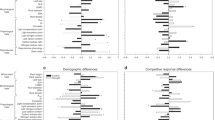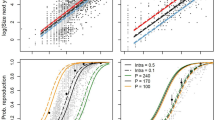Abstract
Although precipitation patterns have long been known to shape plant distributions1, the effect of changing climate on the interactions of species and therefore community composition is far less understood2,3. Here, we explored how changes in precipitation alter competitive dynamics via direct effects on individual species, as well as by the changing strength of competitive interactions between species, using an annual grassland community in California. We grew plants under ambient and reduced precipitation in the field to parameterize a competition model4 with which we quantified the stabilizing niche and fitness differences that determine species coexistence in each rainfall regime. We show that reduced precipitation had little direct effect on species grown alone, but it qualitatively shifted predicted competitive outcomes for 10 of 15 species pairs. In addition, species pairs that were functionally more similar were less likely to experience altered outcomes, indicating that functionally diverse communities may be most threatened by changing interactions. Our results highlight how important it is to account for changes to species interactions when predicting species and community response to global change.
This is a preview of subscription content, access via your institution
Access options
Access Nature and 54 other Nature Portfolio journals
Get Nature+, our best-value online-access subscription
$29.99 / 30 days
cancel any time
Subscribe to this journal
Receive 51 print issues and online access
$199.00 per year
only $3.90 per issue
Buy this article
- Purchase on Springer Link
- Instant access to full article PDF
Prices may be subject to local taxes which are calculated during checkout




Similar content being viewed by others
Data availability
Data are available on Zenodo (https://doi.org/10.5281/zenodo.7083314). Data were recorded in Microsoft Excel (v.16.63.1) and analysed in R (v.4.2.0).
Code availability
Codes are available on Zenodo (https://doi.org/10.5281/zenodo.7083314). Figures and tables were created in R (v.4.2.0).
References
Schimper, A. F. W. Plant Geography upon a Physiological Basis (Clarendon Press, 1903).
Alexander, J. M., Diez, J. M. & Levine, J. M. Novel competitors shape species’ responses to climate change. Nature 525, 515–518 (2015).
HilleRisLambers, J., Harsch, M. A., Ettinger, A. K., Ford, K. R. & Theobald, E. J. How will biotic interactions influence climate change-induced range shifts? Ann. N. Y. Acad. Sci. 1297, 112–125 (2013).
Chesson, P. Mechanisms of maintenance of species diversity. Annu. Rev. Ecol. Syst. 31, 343–366 (2000).
Loarie, S. R., Weiss, S. B., Hamilton, H., Branciforte, R. & Kraft, N. J. B. The geography of climate change: implications for conservation biogeography. Divers. Distrib. 16, 476–487 (2010).
Callaway, R. M. et al. Positive interactions among alpine plants increase with stress. Nature 417, 844–848 (2002).
Dybzinski, R. & Tilman, D. Resource use patterns predict long‐term outcomes of plant competition for nutrients and light. Am. Nat. 170, 305–318 (2007).
Hautier, Y., Niklaus, P. A. & Hector, A. Competition for light causes plant biodiversity loss after eutrophication. Science 324, 636–638 (2009).
Levine, J. M. & HilleRisLambers, J. The importance of niches for the maintenance of species diversity. Nature 461, 254–257 (2009).
Kraft, N. J. B., Godoy, O. & Levine, J. M. Plant functional traits and the multidimensional nature of species coexistence. Proc. Natl Acad. Sci. USA 112, 797–802 (2015).
Knapp, A. K. et al. Rainfall variability, carbon cycling, and plant species diversity in a mesic grassland. Science 298, 2202–2205 (2002).
Sandel, B. et al. Contrasting trait responses in plant communities to experimental and geographic variation in precipitation. New Phytol. 188, 565–575 (2010).
Esch, E. H., Ashbacher, A. C., Kopp, C. W. & Cleland, E. E. Competition reverses the response of shrub seedling mortality and growth along a soil moisture gradient. J. Ecol. 106, 2096–2108 (2018).
Alon, M. & Sternberg, M. Effects of extreme drought on primary production, species composition and species diversity of a Mediterranean annual plant community. J. Veg. Sci. 30, 1045–1061 (2019).
Chesson, P. Updates on mechanisms of maintenance of species diversity. J. Ecol. 106, 1773–1794 (2018).
Barabás, G., D’Andrea, R. & Stump, S. M. Chesson’s coexistence theory. Ecol. Monogr. 88, 277–303 (2018).
Ellner, S. P., Snyder, R. E., Adler, P. B. & Hooker, G. An expanded modern coexistence theory for empirical applications. Ecol. Lett. 22, 3–18 (2019).
Adler, P., Hillerislambers, J. & Levine, J. A niche for neutrality. Ecol. Lett. 10, 95–104 (2007).
Germain, R. M., Mayfield, M. M. & Gilbert, B. The ‘filtering’ metaphor revisited: competition and environment jointly structure invasibility and coexistence. Biol. Lett. 14, 20180460 (2018).
Pau, S. et al. Predicting phenology by integrating ecology, evolution and climate science. Glob. Change Biol. 17, 3633–3643 (2011).
Fargione, J. & Tilman, D. Niche differences in phenology and rooting depth promote coexistence with a dominant C4 bunchgrass. Oecologia 143, 598–606 (2005).
Godoy, O., Kraft, N. J. B. & Levine, J. M. Phylogenetic relatedness and the determinants of competitive outcomes. Ecol. Lett. 17, 836–844 (2014).
Díaz, S. et al. The global spectrum of plant form and function. Nature 529, 167–171 (2016).
Kunstler, G. et al. Plant functional traits have globally consistent effects on competition. Nature 529, 204–207 (2016).
Diffenbaugh, N. S., Swain, D. L. & Touma, D. Anthropogenic warming has increased drought risk in California. Proc. Natl Acad. Sci. USA 112, 3931–3936 (2015).
Swain, D. L., Langenbrunner, B., Neelin, J. D. & Hall, A. Increasing precipitation volatility in twenty-first-century California. Nat. Clim. Change 8, 427–433 (2018).
Chesson, P. Geometry, heterogeneity and competition in variable environments. Phil. Trans. R. Soc. Lond. B 330, 165–173 (1990).
Aronson, J., Kigel, J., Shmida, A. & Klein, J. Adaptive phenology of desert and Mediterranean populations of annual plants grown with and without water stress. Oecologia 89, 17–26 (1992).
Santa Barbara County Public Works water resources hydrology: historical rainfall data: daily and monthly rainfall. County of Santa Barbara http://www.countyofsb.org/pwd/water/downloads/hydro/421dailys.pdf (2019).
Kandlikar, G. S., Kleinhesselink, A. R. & Kraft, N. J. B. Functional traits predict species responses to environmental variation in a California grassland annual plant community. J. Ecol. 110, 833–844 (2022).
Cleland, E. E. et al. Sensitivity of grassland plant community composition to spatial vs. temporal variation in precipitation. Ecology 94, 1687–1696 (2013).
Usinowicz, J. et al. Temporal coexistence mechanisms contribute to the latitudinal gradient in forest diversity. Nature 550, 105–108 (2017).
Kandlikar, G. S., Johnson, C. A., Yan, X., Kraft, N. J. B. & Levine, J. M. Winning and losing with microbes: how microbially mediated fitness differences influence plant diversity. Ecol. Lett. 22, 1178–1191 (2019).
Kleinhesselink, A. R., Kraft, N. J. B., Pacala, S. W. & Levine, J. M. Detecting and interpreting higher order interactions in ecological communities. Ecol. Lett. 25, 1604–1617 (2022).
Saavedra, S. et al. A structural approach for understanding multispecies coexistence. Ecol. Monogr. 87, 470–486 (2017).
Levine, J. I., Levine, J. M., Gibbs, T. & Pacala, S. W. Competition for water and species coexistence in phenologically structured annual plant communities. Ecol. Lett. 25, 1110–1125 (2022).
Farrior, C. E. et al. Resource limitation in a competitive context determines complex plant responses to experimental resource additions. Ecology 94, 2505–2517 (2013).
Harrison, S., Grace, J. B., Davies, K. F., Safford, H. D. & Viers, J. H. Invasion in a diversity hotspot: exotic cover and native richness in the Californian serpentine flora. Ecology 87, 695–703 (2006).
Pérez-Harguindeguy, N. et al. New handbook for standardised measurement of plant functional traits worldwide. Aust. J. Bot. 61, 167–234 (2013).
Godoy, O. & Levine, J. M. Phenology effects on invasion success: insights from coupling field experiments to coexistence theory. Ecology 95, 726–736 (2014).
Acknowledgements
We acknowledge the Chumash peoples as the traditional land caretakers of the area where we planted our experiment, and the Gabrielino/Tongva peoples as the traditional land caretakers of Tovaangar (the Los Angeles basin and So. Channel Islands), where UCLA is located; G. Kandlikar, K. Hayashi and M. Vaz for helpful suggestions and stimulating discussions; A. Kleinhesselink and C. Johnson for help with analyses; H. Lindsay, M. Clarke, A. Dhaliwal, G. Kandlikar, K. Hayashi, A. Kleinhesselink, K. McCurdy, A. Hardy, L. Johnsen, M. Browne, J. Cooch, M. Cowen, S. Montague and F. Van Dyke for laboratory and field assistance. The work was funded by the La Kretz Center at Sedgwick Reserve, a UCLA Vavra fellowship and National Science Foundation grants DEB 164461 and 2022810 and 2022213.
Author information
Authors and Affiliations
Contributions
M.N.V.D. and N.J.B.K. conceived and led the project. M.N.V.D., J.M.L. and N.J.B.K. developed the methods. M.N.V.D. carried out the field experiment and collected the data. Data were analysed and visualized by M.N.V.D. The initial manuscript was written by M.N.V.D. and N.J.B.K., with substantial contributions from J.M.L.
Corresponding author
Ethics declarations
Competing interests
The authors declare no competing interests.
Peer review
Peer review information
Nature thanks the anonymous reviewers for their contribution to the peer review of this work. Peer reviewer reports are available.
Additional information
Publisher’s note Springer Nature remains neutral with regard to jurisdictional claims in published maps and institutional affiliations.
Extended data figures and tables
Extended Data Fig. 1 Effects of water treatment on each competing pairs’ stabilizing niche and fitness differences.
Each species pair shown separately with confidence intervals (+/− 1 SD) for stabilizing niche and fitness differences obtained from bootstrapping. Inside the grey shaded region indicates coexistence, outside indicates competitive exclusion.
Extended Data Fig. 2 Principal component analysis of functional traits from the focal plant community.
Principal component analysis with 23 species and eleven functional traits from previous work at the site10 (Methods). The six species from this study are filled in circles and labeled following Extended Data Table 1. The open circles represent other species in the community. See Extended Data Table 3 for trait descriptions.
Supplementary information
Rights and permissions
Springer Nature or its licensor (e.g. a society or other partner) holds exclusive rights to this article under a publishing agreement with the author(s) or other rightsholder(s); author self-archiving of the accepted manuscript version of this article is solely governed by the terms of such publishing agreement and applicable law.
About this article
Cite this article
Van Dyke, M.N., Levine, J.M. & Kraft, N.J.B. Small rainfall changes drive substantial changes in plant coexistence. Nature 611, 507–511 (2022). https://doi.org/10.1038/s41586-022-05391-9
Received:
Accepted:
Published:
Issue Date:
DOI: https://doi.org/10.1038/s41586-022-05391-9
This article is cited by
-
Integrating field- and remote sensing data to perceive species heterogeneity across a climate gradient
Scientific Reports (2024)
-
Rainfall affects interactions between plant neighbours
Nature (2023)
-
The effects of precipitation change on urban meadows in different design models and substrates
Scientific Reports (2023)
-
The role of neighbouring species in survival as the climate changes
Nature (2022)
Comments
By submitting a comment you agree to abide by our Terms and Community Guidelines. If you find something abusive or that does not comply with our terms or guidelines please flag it as inappropriate.



